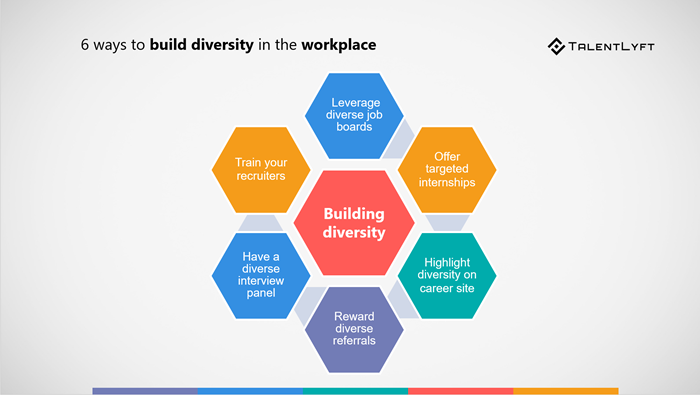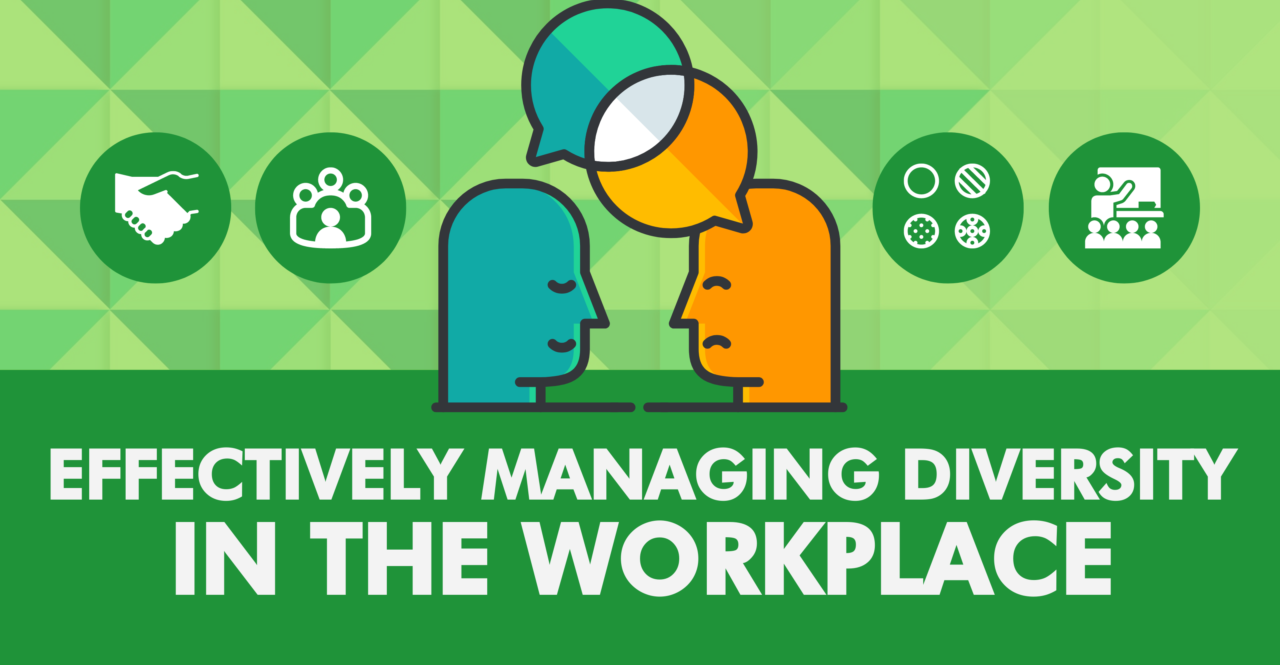How To Manage Diversity In The Workplace
Managing diversity in the workplace involves fostering a culture of inclusion and equality, promoting open communication, and implementing policies and practices that value and respect the unique perspectives, experiences, and backgrounds of all employees. This is crucial for creating a harmonious and productive work environment where everyone feels heard, valued, and encouraged to contribute their best.

Credit: www.talentlyft.com
Benefits Of Diversity
In today’s dynamic and fast-paced business landscape, managing diversity in the workplace has become a key factor in creating a successful organization. Embracing diversity can bring numerous benefits, from increased creativity and innovation to an enhanced problem-solving ability. Let’s delve into these advantages and discover how fostering diversity can give your company a competitive edge.
Increased Creativity And Innovation
Diverse teams bring together individuals with varied backgrounds, experiences, and perspectives. This diversity of thought sparks creativity and fuels innovation within the organization. When employees from different cultures, ethnicities, genders, and age groups collaborate, they contribute unique ideas and insights that can lead to groundbreaking solutions. By encouraging diversity, companies create an environment that stimulates out-of-the-box thinking and drives creative problem-solving.
Increase In Problem-solving Ability
A diverse workforce enhances the organization’s problem-solving ability. When faced with complex challenges, diverse teams can draw upon a wide range of perspectives, knowledge, and skills to develop effective solutions. Each team member can contribute their unique expertise and experience, enabling a comprehensive approach to problem-solving. The diversity of ideas and viewpoints within the team helps in identifying potential issues, analyzing them from different angles, and uncovering innovative solutions that may have been overlooked in a homogeneous team.
Moreover, working with individuals from diverse backgrounds also fosters adaptability and flexibility, essential qualities in a rapidly changing business environment. This ability to navigate diverse perspectives and adapt to various situations enables the organization to overcome obstacles and find optimal solutions.
Challenges Of Managing Diversity
Managing diversity in the workplace presents challenges such as cultural differences, communication barriers, and bias. Effective strategies include fostering an inclusive environment, promoting open dialogue, and offering diversity training for employees. Successful management of diversity can lead to increased productivity, innovation, and a positive work culture.
Language Barriers
Language barriers can be a significant challenge in managing diversity in the workplace. When employees speak different languages, effective communication becomes a major obstacle. Misunderstandings and misinterpretations can occur, leading to confusion and errors in work processes. These language barriers can also create a sense of exclusion among employees who do not speak the dominant language.
Managers can address this challenge by implementing language training programs to improve communication skills, providing translation services or interpreters, and promoting a culture of inclusivity where employees feel comfortable asking for clarification or assistance. By bridging the language gap, organizations can foster better understanding and collaboration among diverse teams.
Cultural Differences
Cultural differences are another significant challenge in managing diversity in the workplace. Each individual brings their own set of beliefs, values, traditions, and behaviors, which may differ greatly from those of others. These differences can lead to misunderstandings, conflicts, and an overall lack of cohesion within the team.
One way to address this challenge is by promoting cultural awareness and sensitivity among employees. Training programs can be implemented to educate employees about different cultures, customs, and etiquettes. Encouraging open discussion and dialogue about cultural differences can also help foster understanding and appreciation.
Creating a diverse and inclusive work environment means valuing and celebrating cultural differences rather than viewing them as obstacles. It is essential to establish a culture of respect and acceptance, where individuals feel comfortable expressing their unique perspectives without fear of being judged or discriminated against.
Creating A Diverse And Inclusive Workplace
Creating a diverse and inclusive workplace is crucial for managing diversity effectively. It involves embracing differences, promoting equality, and fostering an environment where all employees feel valued and respected, ultimately leading to increased productivity and innovation.
Establishing Diversity And Inclusion Goals
Establishing clear diversity and inclusion goals is a crucial first step towards creating a diverse and inclusive workplace. By setting specific objectives, you can outline the direction your organization wants to take and measure progress towards achieving a diverse workforce.
Here are a few key points to consider when establishing diversity and inclusion goals:
- Identify the underrepresented groups within your organization.
- Set realistic and measurable goals that align with your company’s overall mission and values.
- Involve employees from diverse backgrounds in the goal-setting process to ensure inclusivity.
- Regularly communicate the goals and progress to all employees to foster transparency and accountability.
- Continuously evaluate and adjust the goals to stay relevant and responsive to changing demographics and needs.
Implementing Diverse Recruitment Strategies
The recruitment process plays a vital role in building a diverse and inclusive workplace. To attract candidates from various backgrounds and experiences, organizations need to implement effective diverse recruitment strategies.
Consider the following strategies:
- Expand the candidate pool by reaching out to underrepresented communities through targeted job advertisements and partnerships with diverse organizations.
- Train recruiters and hiring managers to recognize unconscious biases and avoid making biased decisions during the selection process.
- Promote diversity and inclusion in job descriptions to attract a wide range of qualified candidates.
- Develop relationships with educational institutions and organizations that support diversity initiatives to access a diverse talent pool.
To ensure each H3 heading adheres to HTML syntax, the heading tags should be enclosed within
and
tags, as shown above.Promoting Cultural Competence
Creating an inclusive and diverse workplace goes beyond simply hiring individuals from different backgrounds. It requires promoting cultural competence throughout the organization. By fostering cultural competence, employees gain the skills and knowledge to navigate and understand different cultures, leading to improved communication, collaboration, and overall harmony within the workplace.
Providing Diversity Training
To promote cultural competence, one effective strategy is to provide comprehensive diversity training for all employees. This training can focus on raising awareness about biases, stereotypes, and cultural differences. By addressing these topics head-on, employees can increase their understanding and empathy towards others, leading to enhanced interactions and a more inclusive work environment.
During diversity training sessions, it is crucial to create a safe space where employees can openly discuss their perspectives and experiences. Provide scenarios or case studies that highlight common cultural misunderstandings in the workplace. Encourage employees to share their own stories and perspectives, fostering an environment of mutual learning and respect.
Encouraging Cross-cultural Communication
Another essential aspect of promoting cultural competence is encouraging cross-cultural communication among employees. This involves creating opportunities for teams to collaborate with individuals from different backgrounds and cultures. When people with diverse viewpoints and experiences come together, it sparks creativity, innovation, and a broader understanding of different perspectives.
Provide platforms for employees to engage in open dialogues and exchange ideas. Encourage the use of inclusive language and active listening during meetings and discussions. By actively promoting cross-cultural communication, employees will become more comfortable interacting with individuals from different backgrounds, fostering a more inclusive and understanding workplace environment.
An effective way to encourage cross-cultural communication is to implement mentorship programs. Pair employees from different cultural backgrounds, allowing them to learn from each other and develop a deeper appreciation for diverse perspectives. These mentorship programs not only promote cultural competence but also help to create stronger relationships and foster career growth.
Fostering Collaboration And Teamwork
Creating a supportive and inclusive environment:
Elevating collaboration and teamwork in the workplace begins with cultivating a supportive and inclusive environment. By prioritizing diversity and respecting each individual’s unique perspectives, experiences, and ideas, teams can thrive and create a sense of belonging for all.
Promoting empathy and understanding:
Recognizing and valuing the differences among team members is crucial for fostering collaboration and teamwork. Encouraging empathy and understanding helps build strong relationships, breaks down barriers, and enhances communication. Creating opportunities for team members to share their stories and perspectives can promote a deeper appreciation for diversity.
Here are a few ways to create a supportive and inclusive environment:
- Nurture open and respectful communication channels
- Implement training programs focused on diversity and inclusion
- Establish clear guidelines that promote fairness and respect
- Encourage collaboration and idea-sharing across different departments
And here are some strategies to promote empathy and understanding:
- Organize team building activities that encourage bonding and empathy
- Provide opportunities for employees to share their diverse backgrounds and experiences
- Facilitate cross-cultural training and workshops
- Promote active listening and encourage individuals to seek out different perspectives
In conclusion, fostering collaboration and teamwork in a diverse workplace requires creating a supportive and inclusive environment, as well as promoting empathy and understanding. By implementing these strategies, organizations can harness the power of diversity and unlock the full potential of their teams.

Credit: www.insperity.com

Credit: sprigghr.com
Frequently Asked Questions For How To Manage Diversity In The Workplace
How Does Diversity Benefit A Workplace?
Diversity in the workplace promotes creativity, innovation, and different perspectives, leading to better problem-solving and increased productivity.
What Are Some Common Challenges In Managing Diversity?
Common challenges in managing diversity include communication barriers, prejudice and stereotypes, and resistance to change.
How Can Employers Foster Diversity And Inclusion?
Employers can foster diversity and inclusion by implementing inclusive hiring practices, providing diversity training, and encouraging open dialogue and collaboration among employees.
Conclusion
The key to successfully managing diversity in the workplace lies in embracing differences, promoting inclusion, and fostering a culture of respect. By valuing unique perspectives and experiences, organizations can enhance creativity, innovation, and productivity. Implementing effective diversity training, fostering open communication, and actively addressing biases and discrimination are crucial steps towards a diverse and inclusive work environment.
With these strategies in place, businesses can thrive by harnessing the power of diversity and unlocking the full potential of their teams.



